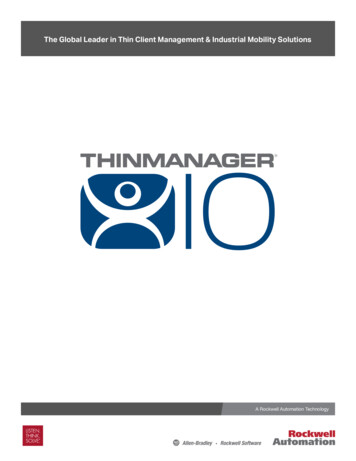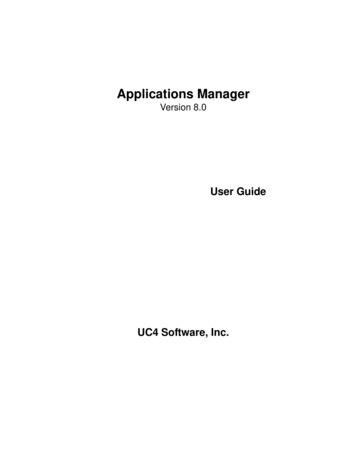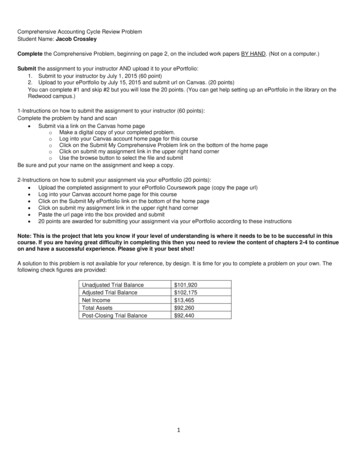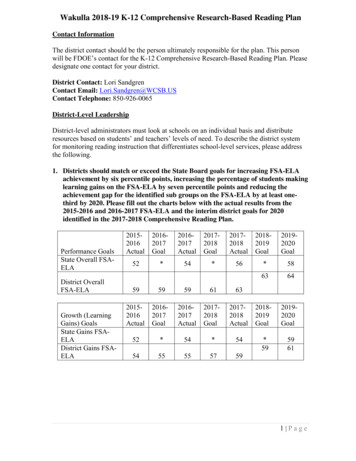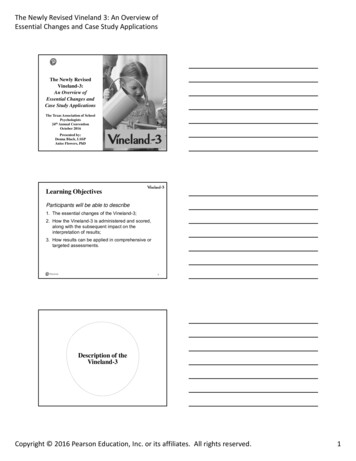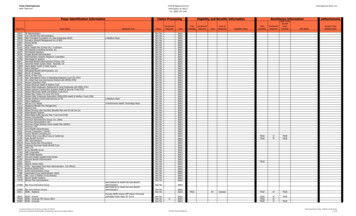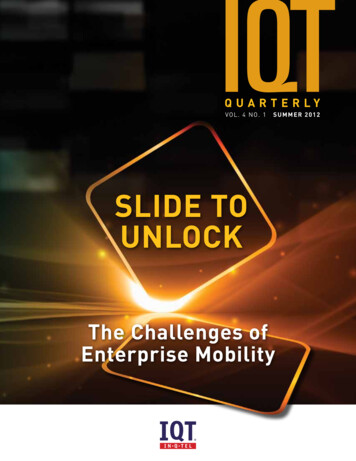
Transcription
A Guide to theSCRUM BODY OF KNOWLEDGE (SBOK GUIDE)Third EditionIncludes two chapters about Scaling Scrum forLarge Projects and the EnterpriseA Comprehensive Guide to Deliver Projects using Scrum
A Guide to theSCRUM BODY OF KNOWLEDGE(SBOK Guide)3rd EditionA Comprehensive Guide to Deliver Projects using Scrum
2016 SCRUMstudy , a brand of VMEdu, Inc. All rights reserved.Library of Congress Cataloging-in-Publication DataA Guide to the Scrum Body of Knowledge (SBOK Guide) –3rd editionIncludes bibliographical references and index.ISBN: 978-0-9899252-0-41. Scrum Framework. I. SCRUMstudy . II. SBOK Guide2013950625ISBN: 978-0-9899252-0-4Published by:SCRUMstudy , a brand of VMEdu, Inc.12725 W. Indian School Road, Suite F-112Avondale, Arizona 85392 USAPhone: 1-480-882-0706Fax: 1-240-238-2987Email: sbok@scrumstudy.comWebsite: www.scrumstudy.com“SBOK”, the SCRUMstudy logo, “SFC”, “SDC”, “SMC”, “SAMC”, “SPOC”, and “ESMC” are trademarks of SCRUMstudy (abrand of VMEdu, Inc.) For a comprehensive list of SCRUMstudy marks, contact the SCRUMstudy Legal Department.A Guide to the Scrum Body of Knowledge (SBOK Guide) is provided for educational purposes. SCRUMstudy or VMEdu,Inc. does not warrant that it is suitable for any other purpose and makes no expressed or implied warranty of any kind andassumes no responsibility for errors and omissions. No liability is assumed for incidental or consequential damages inconnection with or arising out of the use of the information contained herein.SCRUMstudy welcomes corrections and comments on its books. Please feel free to send comments on typographical,formatting, or other errors. You can make a copy of the relevant page of the book, mark the error, and send it to the aboveaddress or send an email to sbok@scrumstudy.com.No part of this work may be reproduced or transmitted in any form or by any means, electronic, manual, photocopying,recording, or by any information storage and retrieval system, without prior written permission of the publisher.10 9 8 7 6 5 4 3 2
PREFACEA Guide to the Scrum Body of Knowledge (SBOK Guide) provides guidelines for the successfulimplementation of Scrum—the most popular Agile product development and project delivery approach.Scrum, as defined in the SBOK Guide, is a framework which is applicable to portfolios, programs, orprojects of any size or complexity; and may be applied effectively in any industry to create a product,service, or other result.The SBOK Guide is intended for use as a reference and knowledge guide by both experienced Scrum andother product or service development practitioners, as well as by persons with no prior experience orknowledge of Scrum or any other project delivery method. This new edition of the SBOK Guide providesadditional insight into Scrum best practices, particularly in the areas of scaling Scrum. Two chapters havebeen added to the SBOK Guide to specifically address scaling Scrum for large projects (Chapter 13), andscaling Scrum for the Enterprise (Chapter 14). As the popularity and application of the Scrum frameworkgrows and evolves globally, our goal is to share the lessons learned and best practices as part of theSBOK Guide.The SBOK Guide draws from the combined knowledge and insight gained from thousands of projectsacross a variety of organizations and industries. This 3rd Edition adds to the collective contributions ofexperts in Scrum and project delivery. In particular, feedback from the global Scrum community played alarge role in identifying improvements and additions to the SBOK Guide. Its development has truly been acollaborative effort from a large number of experts and practitioners in a variety of disciplines.Wide adoption of the SBOK Guide framework standardizes how Scrum is applied to projects acrossorganizations globally, as well as significantly helps to improve their Return on Investment. Additionally, itpromotes greater thought and deliberation regarding the application of Scrum to many types of projects,which will in turn contribute towards expanding and enriching the body of knowledge and consequentlyfuture updates to this guide.Although the SBOK Guide is a comprehensive guide and framework for delivering projects using Scrum,its contents are organized for easy reference, regardless of the reader’s prior knowledge on the subject. Ihope each reader will learn from and enjoy it as much as the many authors and reviewers learned from andenjoyed the process of collating the collective knowledge and wisdom contained within it.Tridibesh Satpathy,Lead Author, SBOK Guide
TABLE OF CONTENTS1.INTRODUCTION . 11.1Overview of Scrum. 21.1.11.2Why Use Scrum? . 41.2.1Scalability of Scrum . 51.3Purpose of the SBOK Guide. 61.4Framework of the SBOK Guide . 71.4.1How to Use the SBOK Guide? . 81.4.2Scrum Principles . 81.4.3Scrum Aspects . 101.4.4Scrum Processes . 151.52.Brief History of Scrum . 3Scrum vs. Traditional Project Management . 20PRINCIPLES . 212.1Introduction . 212.2Roles Guide . 222.3Empirical Process Control . 222.3.1Transparency . 222.3.2Inspection . 242.3.3Adaptation . 242.4Self-organization . 272.4.12.5Benefits of Self-organization . 27Collaboration . 292.5.1Benefits of Collaboration in Scrum Projects . 292.5.2Importance of Colocation in Collaboration . 312.6Value-based Prioritization . 312.7Time-boxing . 332.7.1Scrum Time-boxes . 33
3.2.8Iterative Development . 362.9Scrum vs. Traditional Project Management . 38ORGANIZATION . 393.1Introduction . 393.2Roles Guide . 403.3Scrum Project Roles . 403.3.1Core Roles . 403.3.2Non-core Roles . 423.4Product Owner . 443.4.1Voice of the Customer (VOC) . 453.4.2Chief Product Owner . 453.4.3Program Product Owner. 463.4.4Portfolio Product Owner . 463.5Scrum Master. 473.5.1Chief Scrum Master . 483.5.2Program Scrum Master . 493.5.3Portfolio Scrum Master . 503.6Scrum Team . 503.6.1Personnel Selection . 513.6.2Scrum Team Size . 523.7Scrum in Projects, Programs, and Portfolios. 523.7.1Definition of Project, Program, and Portfolio . 523.7.2Maintaining Stakeholder Involvement . 543.8Summary of Responsibilities . 563.9Scrum vs. Traditional Project Management . 573.10Popular HR Theories and their Relevance to Scrum . 583.10.1Tuckman’s Model of Group Dynamics . 583.10.2Conflict Management . 593.10.3Conflict Management Techniques. 593.10.4Leadership Styles . 603.10.5Maslow’s Hierarchy of Needs Theory. 63
3.10.64.Theory X and Theory Y. 64BUSINESS JUSTIFICATION . 654.1Introduction . 654.2Roles Guide . 664.3Value-driven Delivery . 664.3.1Responsibilities of the Product Owner in Business Justification . 684.3.2Responsibilities of Other Scrum Roles in Business Justification . 684.4Importance of Business Justification . 694.4.1Factors Used to Determine Business Justification . 694.4.2Business Justification and the Project Lifecycle . 704.5Business Justification Techniques . 724.5.1Estimation of Project Value . 724.5.2Planning for Value . 744.5.3Relative Prioritization Ranking . 764.5.4Story Mapping . 764.6Continuous Value Justification . 764.6.1Earned Value Analysis. 774.6.2Cumulative Flow Diagram (CFD) . 794.7Confirm Benefits Realization . 804.7.1Prototypes, Simulations, and Demonstrations . 804.8Summary of Responsibilities . 814.9Scrum vs. Traditional Project Management . 82APPENDIX B. SBOK GUIDE AUTHORS AND CONTRIBUTORS. 83APPENDIX C. THIRD EDITION UPDATES. 86REFERENCES . 89GLOSSARY . 90INDEX. 130
LIST OF FIGURESLIST OF FIGURESFigure 1-1: Scrum Flow for One Sprint. 2Figure 1-2: SBOK Guide Framework. 7Figure 1-3: Scrum Principles . 9Figure 1-4: Organization in Scrum . 12Figure 2-1: Transparency in Scrum . 23Figure 2-2: Inspection in Scrum . 24Figure 2-3: Adaptation in Scrum . 25Figure 2-4: Challenges in Traditional Project Management . 26Figure 2-5: Goals of a Self-Organizing Team . 28Figure 2-6: Benefits of Collaboration in Scrum Projects . 30Figure 2-7: Value-based Prioritization . 32Figure 2-8: Time-Box Durations for Scrum Meetings. 35Figure 2-9: Scrum vs. Traditional Waterfall . 37Figure 3-1: Scrum Roles—Overview . 42Figure 3-2: Questions asked during a Scrum of Scrums Meeting . 48Figure 3-3: Desirable Traits for the Core Scrum Roles . 51Figure 3-4: Scrum Across the Organization for Projects, Programs, and Portfolios . 53Figure 3-5: Tuckman’s Stages of Group Development. 58Figure 3-6: Maslow’s Hierarchy of Needs Theory. 63Figure 4-1: Delivering Value in Scrum vs. Traditional Projects . 67Figure 4-2: Hierarchy for Business Justification Responsibilities. 68Figure 4-3: Business Justification and the Project Lifecycle . 71Figure 4-4: Kano Analysis . 75Figure 4-5: Sample Cumulative Flow Diagram (CFD) . 79 2016 SCRUMstudy . A Guide to the Scrum Body of Knowledge (SBOK Guide)IX
LIST OF TABLESTable 1-1: Summary of Fundamental Scrum Processes . 15Table 1-2: Summary of Additional Scrum Processes . 16Table 1-3: Scrum vs. Traditional Project Management. 20Table 3-1: Responsibilities of the Product Owner in Scrum Processes . 45Table 3-2: Responsibilities of the Scrum Master in Scrum Processes . 48Table 3-3: Responsibilities of the Scrum Team in Scrum Processes . 51Table 3-4: Summary of Responsibilities Relevant to Organization . 56Table 4-1: Earned Value Formulas. 77Table 4-2: Summary of Responsibilities Relevant to Business Justification. 81
1 – INTRODUCTION1. INTRODUCTION1A Guide to the Scrum Body of Knowledge (SBOK Guide) provides guidelines for the successfulimplementation of Scrum—the most popular Agile project management and product development approach.It provides a comprehensive framework that includes the principles, aspects, and processes of Scrum.Scrum, as defined in the SBOK Guide, is applicable to the following: Portfolios, programs, and/or projects in any industryProducts, services, or any other results to be delivered to stakeholdersProjects of any size or complexityThe term “product” in the SBOK Guide may refer to a product, service, or other deliverable. Scrum can beapplied effectively to any project in any industry—from small projects or teams with as few as six teammembers to large, complex projects with up to several hundred team members.This first chapter describes the purpose and framework of the SBOK Guide and provides an introductionto the key concepts of Scrum. It contains a summary of Scrum principles, Scrum aspects and Scrumprocesses. Chapter 2 expands on the six Scrum principles which are the foundation on which the Scrumframework is based. Chapters 3 through 7 elaborate on the five Scrum aspects that must be addressedthroughout any project: organization, business justification, quality, change, and risk. Chapters 8 through 12cover the 19 Scrum processes involved in carrying out a Scrum project. These processes are part of the fiveScrum phases: Initiate; Plan and Estimate; Implement, Review and Retrospect; and Release. These phasesdescribe in detail the associated inputs and outputs of each process, as well as the various tools that may beused in each process. Some inputs, tools, and outputs are mandatory and are indicated as such; others areoptional depending on the specific project, organizational requirements, and/or guidelines set forth by theorganization’s Scrum Guidance Body (SGB). Chapters 13 and 14 are new additions to the SBOK Guide,which provide guidance on Scaling Scrum for Large Projects and Scaling Scrum for the Enterprise.This chapter is divided into the following sections:1.1 Overview of Scrum1.2 Why Use Scrum?1.3 Purpose of the SBOK Guide1.4 Framework of the SBOK Guide1.5 Scrum vs. Traditional Project Management 2016 SCRUMstudy . A Guide to the Scrum Body of Knowledge (SBOK Guide)1
1 – INTRODUCTION1.1Overview of ScrumA Scrum project involves a collaborative effort to create a new product, service, or other result as defined inthe Project Vision Statement. Projects are impacted by constraints of time, cost, scope, quality, resources,organizational capabilities, and other limitations that make them difficult to plan, execute, manage, andultimately succeed. However, successful implementation of the results of a finished project providessignificant business benefits to an organization. It is therefore important for organizations to select andpractice an appropriate project management approach.Scrum is one of the most popular Agile methods. It is an adaptive, iterative, fast, flexible, and effectiveframework designed to deliver significant value quickly and throughout a project. Scrum ensurestransparency in communication and creates an environment of collective accountability and continuousprogress. The Scrum framework, as defined in the SBOK Guide, is structured in such a way that itsupports product and service development in all types of industries and in any type of project, irrespective ofits complexity.A key strength of Scrum lies in its use of cross-functional, self-organized, and empowered teams who dividetheir work into short, concentrated work cycles called Sprints. Figure 1-1 provides an overview of a Scrumproject’s flow.Figure 1-1: Scrum Flow for One SprintThe Scrum cycle begins with a Stakeholder Meeting, during which the Project Vision is created. The ProductOwner then develops a Prioritized Product Backlog which contains a prioritized list of business and projectrequirements written in the form of User Stories. Each Sprint begins with a Sprint Planning Meeting duringwhich high priority User Stories are considered for inclusion in the Sprint. A Sprint generally lasts betweenone and six weeks and involves the Scrum Team working to create potentially shippable Deliverables or2 2016 SCRUMstudy . A Guide to the Scrum Body of Knowledge (SBOK Guide)
1 – INTRODUCTIONproduct increments. During the Sprint, short, highly focused Daily Standup Meetings are conducted whereteam members discuss daily progress. Toward the end of the Sprint, a Sprint Review Meeting is held duringwhich the Product Owner and relevant stakeholders are provided a demonstration of the Deliverables. TheProduct Owner accepts the Deliverables only if they meet the predefined Acceptance Criteria. The Sprintcycle ends with a Retrospect Sprint Meeting where the team discusses ways to improve processes andperformance as they move forward into the subsequent Sprint.1.1.11Brief History of ScrumIn the mid 80’s, Hirotaka Takeuchi and Ikujiro Nonaka defined a flexible and all-inclusive productdevelopment strategy where the development team works as a unit to reach a common goal. Theydescribed an innovative approach to product development that they called a holistic or “rugby” approach,“where a team tries to go the distance as a unit, passing the ball back and forth.” They based their approachon manufacturing case studies from various industries. Takeuchi and Nonaka proposed that productdevelopment should not be like a sequential relay race, but rather should be analogous to the game of rugbywhere the team works together, passing the ball back and forth as they move as a unit down the field. Therugby concept of a “Scrum” (where a group of players form together to restart the game) was introduced inthis article to describe the authors’ proposal that product development should involve “moving the Scrumdownfield”.Ken Schwaber and Jeff Sutherland elaborated on the Scrum concept and its applicability to softwaredevelopment in a presentation at the Object-Oriented Programming, Systems, Languages & Applications(OOPSLA) conference held in 1995 in Austin, Texas. Since then, several Scrum practitioners, experts, andauthors have continued to refine the Scrum conceptualization and framework. In recent years, Scrum hasincreased in popularity and is now the preferred project development approach for many organizationsglobally. 2016 SCRUMstudy . A Guide to the Scrum Body of Knowledge (SBOK Guide)3
1 – INTRODUCTION1.2Why Use Scrum?Some of the key benefits of using Scrum in any project are:1. Adaptability—Empirical process control and iterative delivery make projects adaptable and open toincorporating change.2. Transparency—All information radiators like a Scrumboard and Sprint Burndown Chart are shared,leading to an open work environment.3. Continuous Feedback—Continuous feedback is provided through the Conduct Daily Standup, andDemonstrate and Validate Sprint processes.4. Continuous Improvement—The deliverables are improved progressively Sprint by Sprint, throughthe Groom Prioritized Product Backlog process.5. Continuous Delivery of Value—Iterative processes enable the continuous delivery of valuethrough the Ship Deliverables process as frequently as the customer requires.6. Sustainable Pace—Scrum processes are designed such that the people involved can work at asustainable pace that they can, in theory, continue indefinitely.7. Early Delivery of High Value—The Create Prioritized Product Backlog process ensures that thehighest value requirements of the customer are satisfied first.8. Efficient Development Process—Time-boxing and minimizing non-essential work leads to higherefficiency levels.9. Motivation—The Conduct Daily Standup and Retrospect Sprint processes lead to greater levels ofmotivation among employees.10. Faster Problem Resolution—Collaboration and colocation of cross-functional teams lead to fasterproblem solving.11. Effective Deliverables—The Create Prioritized Product Backlog process and regular reviews aftercreating deliverables ensures effective deliverables to the customer.12. Customer Centric—Emphasis on business value and having a collaborative approach tostakeholders ensures a customer-oriented framework.4 2016 SCRUMstudy . A Guide to the Scrum Body of Knowledge (SBOK Guide)
1 – INTRODUCTION13. High Trust Environment—Conduct Daily Standup and Retrospect Sprint processes promotetransparency and collaboration, leading to a high trust work environment ensuring low frictionamong employees.114. Collective Ownership—The Commit User Stories process allows team members to takeownership of the project and their work leading to better quality.15. High Velocity—A collaborative framework enables highly skilled cross-functional teams to achievetheir full potential and high velocity.16. Innovative Environment—The Retrospect Sprint and Retrospect Project processes create anenvironment of introspection, learning, and adaptability leading to an innovative and creative workenvironment.1.2.1Scalability of ScrumTo be effective, Scrum Teams should ideally have six to ten members. This practice may be the reason forthe misconception that the Scrum framework can only be used for small projects. However, it can easily bescaled for effective use in large projects, programs, and portfolios. In situations where the Scrum Team sizeexceeds ten people, multiple Scrum Teams can be formed to work on the project. The logical approach ofthe guidelines and princi
A Guide to the Scrum Body of Knowledge(SBOK Guide) provides guidelines for the successful implementation of Scrum—the most popular Agile product development and project delivery approach. Scrum, as defined in the SBOK Guide, is a



